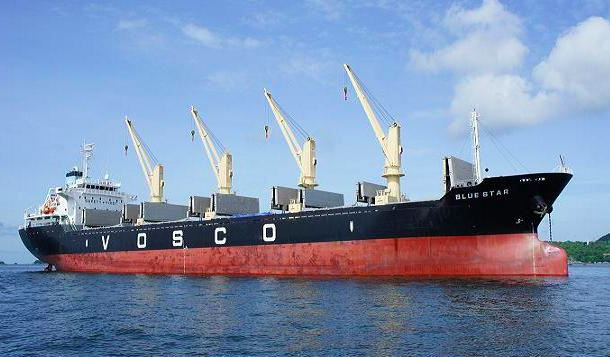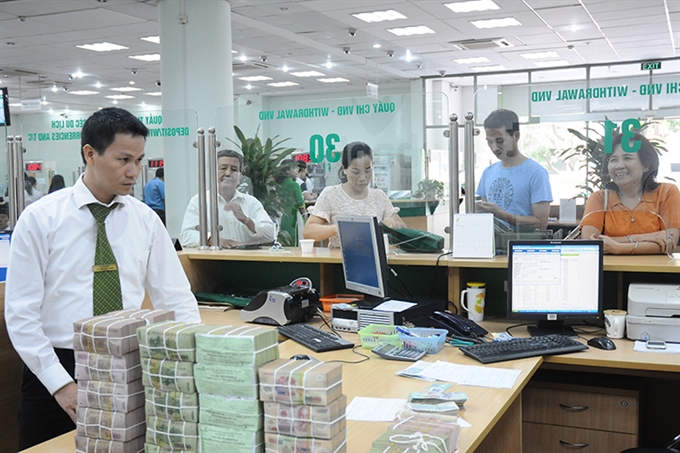 Economy
Economy

Việt Nam seemed to have adopted a loose monetary policy - an expanded national monetary supply easilly accessible to citizens to encourage economic growth. But it has not done so.
 |
| Banking credit growth this year has been 4.52 per cent compared with 4.26 per cent in the same period last year. — Photo baocongthuong.com.vn |
Việt Nam seemed to have adopted a loose monetary policy - an expanded national monetary supply easilly accessible to citizens to encourage economic growth. But it has not done so. Some analysts point to several of the following factors which they say prove a loose monetary policy:
The State Bank of Việt Nam (SBV) reported on May 20, money supply has increased by 5.88 per cent this year compared to 2.24 in the same period last year.
Banking credit growth this year has been 4.52 per cent compared with 4.26 per cent in the same period last year.
In HCM City, where lending is the highest in the country, credit growth this year has been 5 per cent, the highest level in three years.
Some major banks like BIDV estimate credit has increased by 8-9 per cent, while Vietcombank reported a 6.3 per cent growth, and ACB, 7.6 per cent.
The analysts said Circulars No 06/2016/TT-NHNN and 07/TT-NHNN from the SBV resolved several issues, enabling commercial banks to increase their credit growth.
But a central bank official, who declined to be named, said deposit interest rates are continuing to rise, meaning banks still lack liquidity, a basic necessity to loosen monetary policy.
So what accounts for the significant credit growth if not policy loosening?
The market has seen some favourable occurrences like the economic recovery and businesses’ increasing demand for credit to expand their production and trading activities, especially since lending interest rates are down sharply from just a few years ago.
Demand for credit from individuals to fund purchase of consumer goods and houses has also increased.
Analysts expect the demand to further rise since foreign direct investment has increased sharply in recent months and is expected to keep rising.
This would result in an increase in demand for funds from many other sectors to serve the foreign investors’ needs like industrial parks, infrastructure, office space and services.
But analysts are against loosening policy though the economy has shown some positive signs, saying the time is not ripe yet and could pose risks to the economy.
They fear that if banks do not lend fearing the returns will be low, money could flow into other assets pushing up their prices.
This could cause cost-push inflation due to a substantial rise in the cost of many goods or services that lack suitable alternatives.
To avoid this, experts said the government should improve the effectiveness of the restructuring of the banking sector and State-owned enterprises to ensure that money is used carefully and efficiently.
Recently the SBV issued a directive to regulate monetary policies and the banking sector’s operations this year.
Agencies under the central bank have to closely monitor and control credit growth to have proper measures to address problems that may arise.
The central bank has also called for a close watch on credit institutions with large exposure to certain risky industries and sectors that have also reported rapid credit growth.
In a resolution passed at the monthly Cabinet meeting in May, the Government urged State-owned enterprises to quickly complete withdrawal from non-core sectors, especially banking.
It is estimated that in banks, SOEs including giant players like EVN, PetroVietnam and MobiFone have invested around VNĐ10 trillion (over US$444.44 million).
PVcomBank is the lender in which SOEs have the largest stakes, with PetroVietnam alone owning 52 per cent in the bank.
Current legal regulations allow a single institutional shareholder to own a maximum of 15 per cent in a bank, while institutions can hold a combined 20 per cent.
But despite its huge stake in PVcomBank, PVN has no plans to discuss selling its shares at its shareholders meeting this month.
A PVN source said last year the company drew up a proposal to sell its stakes in PVcomBank to the State Bank of Việt Nam. It was reportedly submitted to the Government for approval, but nothing has come of it yet.
MobiFone has also faced many problems in selling its stakes in banks. Recently it wanted to sell 14.3 million shares in TPBank, but managed to sell less than 39 per cent of them.
Its attempt to sell off its 33.4 million shares in SeABank (6.12 per cent of the bank’s prescribed capital) also failed, as only two million shares were bought.
VNPT has been unable to pull out of Maritime Bank, in which it owns 71.5 million shares worth VNĐ700 billion (US$31.11 million).
In 2015 electricity monopoly EVN offered for sale 82 million shares of ABBank, which accounted for 21.27 per cent of the lender’s chartered capital, but managed to sell only 50 per cent.
So far only Petrolimex and PVGas have successfully sold their stakes in PGBank and SeABank.
The reason they are struggling to sell shares in banks is that the prices of many of them have tumbled in the market, some to as low as VNĐ5,000.
The SOEs do not want to sell them at such low prices because they have been warned not to squander away public money.
Besides, SOEs must have their pullout plans approved by the central bank in case they want to sell their stakes in certain sectors like banking and finance.
For the central bank too the State-owned firms’ pullout from banks is a headache since it is not easy for the lenders to find new investors with good financial and management capabilities.
Analysts said the easiest way out is for the central bank to buy out the firms’stakes in the banks or require the banks themselves to buy back.
But the SBV does not want to take on the job since it does not have enough human resources or the funds.
All this means the vexing question of how SOEs can sell their shares in banks while ensuring no one loses still has no answer.
The consumer price index has been increasing for the last five months.
Following a 1.89 per cent year-on-year rise in April, it rose by 2.28 per cent in May, the highest rate since November 2014.
Prices of most goods and services in the basket making up the index have been rising.
Food was up by 2.36 per cent, beverages and tobacco by 2.37 per cent, garments by 2.31 per cent, housing and construction by 1.67 per cent, medicines by 26.8 per cent, education by 4.55 per cent, culture and entertainment by 1.57 per cent, and other goods and services by 2.23 per cent.
Only transport (9.76 percent) and post and telecom (0.58 percent) prices declined.
The inflation rate is likely to be sharply up in the remaining seven months of the year.
It averaged 6.73 percent in the two decades from 1996 to 2016, reaching an all-time high of 28.24 percent in August 2008 and a low of -2.60 percent in July 2000.
Analysts listed the most likely causes of inflation: The cost of healthcare is set to be adjusted upward in July; global fuel prices are creeping up again and are likely to have a knock-on effect on the prices of many other items, including consumer goods.
The global fuel price has increased by 60 per cent in the last two months to US$50 per barrel and is expected to keep rising.
A food shortage due to the prolonged drought and pollution could create pressure on the prices of food and beverages.
The high budget deficit is another contributing factor. According to the Ministry of Planning and Investment, in the first five months of the year the budget deficit reached VNĐ66.4 trillion (US$2.95 billion) and the figure is estimated to top VNĐ254 trillion by year-end.
The strong credit growth is another major inflationary factor.
Credit has grown by 5.48 per cent this year, the highest in the last few years, according to the State Bank of Viet Nam’s Credit Department.
Year-on-year the growth has been 17.59 per cent.
The trend is expected to continue especially after the central bank issues Circulars No.6 and No.7 that are likely to loosen monetary policy. — VNS